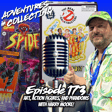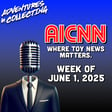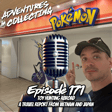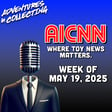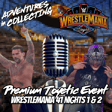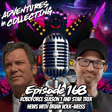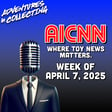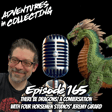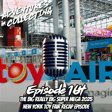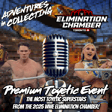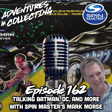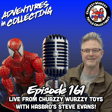Become a Creator today!Start creating today - Share your story with the world!
Start for free
00:00:00
00:00:01

An Interview with Legendary Toy Designer Stefanie Eskander
On this episode, Dave and Erik sit down with the legendary toy designer behind Wrestling Buddies, Moon Dreamers, Jem and the Holograms, and more, Stefanie Eskander! Hear stories behind some of these iconic toy lines and how the design process has changed over the years - as well as questions from YOU, our listeners!
Learn more about Stefanie and her work!
https://stefanieeskanderdesign.com
Follow Stefanie on Instagram @stefdesignstoys and @stefcollectsstuff
Follow us @aic_podcast on Instagram, Facebook, Twitter, and YouTube
Intro and other voices by Joe Azzari
https://www.instagram.com/voicesbyjoe/
Theme Music is "Game Boy Horror" by the Zombie Dandies
Proudly part of the Non-Productive Network
Advertising Inquiries: https://redcircle.com/brands
Privacy & Opt-Out: https://redcircle.com/privacy
Transcript
Introduction to Podcast
00:00:02
Speaker
Are you ready, kids? Get your parents' permission, check your mailbox, and grab your shopping cart. It's time for the Adventures in Collecting podcast. I'm Eric. And I'm Dave.
Dave's Catchphrases and Merch
00:00:16
Speaker
Welcome to Adventures in Collecting, where we talk toy news, culture, and halls, along with our journeys as collectors. Hello, everyone, and welcome back to Adventures in Collecting. Hello.
00:00:32
Speaker
I love it. Always bring in the energy. There it is for everyone. There's the hello. One of these days, Dave, one of these days, we're going to do merch and your shirt is just going to say hello. Yeah, my two catchphrases are hello and yeah. So Dave, what am I going to say? Why don't you, do you want to say it for me or should I say it this time? This is your shirt.
Meet Stephanie Escander
00:00:57
Speaker
Eric, do we have a lead to bury today? We don't, Dave. So I'm not going to bury the lead. We are joined today by a very special guest. We are joined by somebody who has been directly involved with some of the, let's just say, legendary toys throughout the years. Gem in the Holograms, the Cabbage Patch Kids, Polly Pocket, wrestling buddies,
00:01:24
Speaker
There are so many more, I could spend the entire intro naming the cool things that you have designed, but Stephanie Escander is joining us today. Stephanie, welcome to Adventures in Collecting. Thank you so much, Eric and Dave. I'm really happy to be here with you today. The honor is all ours and we're happy to have you on. Yes, absolutely.
Downsizing and Recollecting Toys
00:01:52
Speaker
So before we jump in and start learning about all of the amazing things that you've done for the toy industry, the first thing we like to ask all of our guests is what they're currently collecting or what you're excited about collecting? That's really a funny question because I'm actually at the point in my life where I'm downsizing my collections. I've been a pretty heavy-duty collector of
00:02:22
Speaker
a myriad of things, not just toys. But a few years ago, we moved to a small townhome, and there wasn't room for a lot of my collections. And so we kind of have slowly been
00:02:38
Speaker
selling them, giving them away, just downsizing. But what I'm currently collecting is I seem to be collecting the toys that I designed, which for various reasons, I have not always had a copy of every toy that I've designed. If I did, it would fill up multiple rooms. But it wasn't as important to me to have those toys, although a lot of them I did have.
00:03:08
Speaker
gave them to my own children to play with when they were small. But I seem to have sold off a bunch of them when we downsized. And so now my big job is to try to collect them back. And so I've been going on eBay and Etsy. And then I've got people who are followers of me on Instagram who have generously just sent me things. Oh, you designed that? I'll just send you this thing. So I'll get a box.
00:03:36
Speaker
with something in it that I designed and I'm so grateful for that. So that seems to be the focus of my collecting right now.
The Copycat Collector Blog
00:03:45
Speaker
But I mentioned that I was a serious collector. Back in 2011, I decided to start a blog and it was called The Copycat Collector.
00:03:59
Speaker
And I decided I was actually inspired by a woman who posted one collection of hers every single day for a year. So I decided to do the same thing. So from July 1st, 2011 to June 30th, 2012, I had a collector blog, which is still there, where I posted a different collection every weekday. So Monday through Friday. And then on the weekend, I would post or I would link someone else's collection. And
00:04:28
Speaker
it was you know toys and books and pottery and depression glass and musical instruments and All kinds of interesting things I figured if I had three or more of it it was a collection and Anyway, I got through that year and the thing that was the most awesome about it was that I was able to photograph almost everything I owned that was a collectible and post it on this blog and then
00:04:56
Speaker
And then later, it wasn't long after that, that we downsized and I got rid of things. I had it documented. So I was really glad that I had spent that year going through everything, seeing what I had and then posting it. So it's out there in cyber land.
Collecting Vintage Children's Books
00:05:14
Speaker
Well, keeping, keeping, uh, keeping a collection of any kind organized is an ordeal. So, I mean, that's, you're effectively killing two birds with one stone there. Exactly.
00:05:27
Speaker
So, you know, from that time where you were showing off all of the various collections and collectibles, what was your favorite little micro collection there? You know, that's really a hard question because I collect such a variety of things and I had so many favorites, but I think the thing that was kind of dearest to my heart and something that I really, I've managed to hold on to
00:05:53
Speaker
was I collect vintage school books, children's, you know, elementary school readers, Dick and Jane kind of readers and primers and workbooks and arithmetic books. They generally date from the 40s up to the 60s. So even though I'm not quite that old,
00:06:14
Speaker
I did grow up with a lot of these books as a child and I found certain series of books. It was really important to me to try to finish a series. So there might be a series of Alice and Jerry books and you try to get the primers and the first grade and the second grade, you try to get all of them up to the sixth grade, which generally was most schools back then were
00:06:37
Speaker
either up to sixth grade or to eighth grade for elementary school. And so I have music books, art books, science books, math books, readers, health books, social studies, geography,
00:06:50
Speaker
And I really kept an awful lot of them. I think a lot of it is the artwork, the beautiful illustrations of children. Most of these, because of the time they were published, it was a more innocent, sweet time. They tend to not be particularly diverse. That was a cultural thing that was pretty prevalent. But as it got up into the 60s, then you'd see more of the books had more of a diverse group of kids in them.
00:07:20
Speaker
I really like the younger books, the first and second grade, kindergarten, those kinds of books. The older books are a little bit too wordy and not as many illustrations, so I don't like them as well. But I think those have been really dear to my heart, and I still love to look at them.
00:07:39
Speaker
you know, close my eyes and envision some of those like covers and like just the kind of, you know, very, you know, plain but well-drawn children and, you know, all of those kind of like timeless looks.
From Illustrator to Toy Designer
00:07:52
Speaker
But speaking about art, you know, and the art in these books, how did you really get into the art of making toys? Well, actually, I guess you could say it's a really direct relationship because
00:08:09
Speaker
From the time I was a little girl, I knew I was gonna be an artist, and I wanted to be a children's artist. I wanted to illustrate children's books, and I was a huge reader from the time I was little, and loved picture books, loved story books, and I had certain favorite illustrators as a child that I followed them zealously. I mean, I would read the books almost more because of the artwork than because of the story,
00:08:37
Speaker
so when I went to college I majored in illustration and And my emphasis was children's illustration and I started illustrating for children's magazines when I was still in college And I had no clue about toys as a as a field I mean it never crossed my mind that nobody ever mentioned that I didn't think about it and so when I got out of college I became a an advertising illustrator and
00:09:05
Speaker
And I worked in Los Angeles at one of the biggest advertising agencies in LA. But as time progressed, I started picking up more and more children's work. So I would do the advertising art for Disneyland or Knott's Berry Farm, or, you know, I did all the children's menu art for Denny's restaurants and that kind of thing. I had always done a lot of kids work. And then I started doing storyboards for Mattel's ad agency and Tomy Toy's ad agency.
00:09:35
Speaker
And that's what led me into the toy industry. So I'd been doing artwork in the early eighties for these Los Angeles toy companies. And then in the fall of 1984, Mattel had a job fair and I had enough children's art in my portfolio that I just took a chance and went down to this job fair in Hawthorne and interviewed and they hired me just like right then.
00:10:03
Speaker
That's how I began to illustrate or to design toys.
Transitioning from 2D to 3D Design
00:10:07
Speaker
And that's, it's a direct relationship from that art that I loved as a child. So, so Mattel was, was the first, uh, the first real toy gig then that you had. Uh, before I went to Mattel, I actually was freelancing for a company called Small World Toys, uh, which is a, a small toy company in the Los Angeles area.
00:10:32
Speaker
I had originally been hired to through their advertising agency to do some illustrations, some artwork for their boxes, for their dolls, a couple of doll lines. And that led me to designing a line of puzzles. You know, those wooden puzzles that have the little peg you lift up and little animals. So I did a line of puzzles for small world toys as a freelancer. And so again, because so when I went to Mattel,
00:11:02
Speaker
I did have a little bit of toy product to show them. So those are kind of what I consider my first toy ventures, but Mattel was my first full-time toy gig. So what was it like taking the experience you had in advertising and like 2D art and translating that into physical objects, 3D things that kids were then playing with?
00:11:31
Speaker
That is such an excellent question because that was such, that was the hardest thing for me. I was a 2D artist. And it's also interesting because the toy industry has changed in a lot of ways since the eighties when I got into it. Back when I went to Mattel, almost all my colleagues were children's illustrators. You know, they had worked for Hallmark or they illustrated children's books or they were, you know,
00:11:59
Speaker
did other kinds of children's products, greeting cards. And so all of us were 2D artists. And all of a sudden I was expected to know how to design playsets and 3D things and learn how to do the kind of drawings that you do. We call them control drawings, but the drawings where you do the front view, the side view, the back view, the top view, all of those views. And I had to learn how to do that.
00:12:24
Speaker
That was probably the hardest thing for me to do but you do what you need
Impact of Digital Design Tools
00:12:29
Speaker
to learn, right? I mean if you if to be a successful toy designer you have to learn how to design in 3d you just do it and You know, there certainly are people who come into the toy industry with more of a product design or an industrial design background and I think those programs probably lend themselves much more readily to
00:12:51
Speaker
3D toys. But in my opinion, my illustration background gave me a personal style of drawing and a whimsy and an ability to create characters that really can't be taught. You can improve and you can learn things, but I think not every toy designer can do everything, right? And so some people are better at developing characters and faces and
00:13:18
Speaker
And that kind of thing. Others are better at doing more of the technical aspects. But for me, I wanted to design the aesthetics and make things cute. I mean, after all, my background was more with typically female type of toys, girls things. I was a girl myself. So I was much more attracted to a style of art that was more girly. And so I just worked really hard.
00:13:45
Speaker
Today, I know students have to learn more 3D programs and things, but that didn't really exist back in the 80s.
Evolution of Toy Industry
00:13:53
Speaker
We were creating three dimensions by drawing two dimensionally. Well, that was going to be my next question. You've been in the industry
00:14:09
Speaker
to the point where everything was by hand and you got it, got to kind of witness the advent of Adobe and, you know, InDesign and, and all of these, uh, you know, a Wacom tablet and all of the tools that, you know, are now kind of at the hands of, of digital design. Um, how, how has technology kind of affected your process personally? It's actually been awesome. I mean, I can't, I, I, uh, I've been amazed how much technology has
00:14:39
Speaker
has improved my skills and has enhanced them. That said, not every designer who's of my generation has taken readily to technology. And even with me, it was a struggle. I first became aware, I guess, of technology used in design process in the early 90s when I was at Fisher Price.
00:15:09
Speaker
They had a lot of skilled CAD designers, that kind of thing, who were working already on computer-aided design. But we regular designers were asked to take, they had in-house computer classes for us to take. And it was really hard for me. It just didn't go the way my brain did. And it took me a couple of years. By that time, I'd moved on to Mattel for the second time. I worked for Mattel twice.
00:15:39
Speaker
This was in I went back to Mattel in 1995. So we're talking 95 through 97 I Really needed to up my skill level in Dolby products. And so I started in Illustrator and got fairly proficient and then at the end of 97 I left Mattel and went on my own for the next 12 years and had my own studio at home and that became really difficult because I couldn't afford by a computer
00:16:09
Speaker
I mean, I was now freelancing and that was when the iMac first came out. And I got my first computer in 2000. So between 98 and 2000, I used to go down to Kinko's, they had computers you could rent. You could sit in a little office and rent a Mac. And so I would go down there and I would do whatever little label art or some little thing that I had to do on the computer. But mostly I was still drawing by hand because I didn't have a computer.
00:16:38
Speaker
Then once I got my computer and I became pretty proficient in Illustrator and Photoshop and just continue to develop my skills, I just enhanced my abilities. But I still primarily drew and draw to this day by hand. So you mentioned that the industry has changed over the years. How has it really shifted or how have you seen it shift? Well, in many ways it's gotten
00:17:08
Speaker
better. In other words, technology is improved. Things are faster. Communication. For the first 10 years that I was in the toy industry, we didn't even have email. We didn't have computers in our offices. Everything was done by hand.
00:17:27
Speaker
You used a blueprint machine, you used a fax machine, you faxed your drawings. We had photocopiers, obviously, but it was slower. We didn't have communications with our counterparts in Hong Kong and China. It was tough. Communications really improved. I think
00:17:51
Speaker
to a certain extent, skill level has improved. The aesthetics of toys have changed dramatically, both in traditionally boys toys and traditionally girls toys. I don't think that there's anybody who can deny that
00:18:09
Speaker
toys, especially, you know, action figures and kind of boys toys, that they've gotten a million times more complex and beautifully done. I mean, there are a lot more realistic, the sculpture, I mean, if you look at, you know, an action figure from the 80s, and you look at an action figure from 2010, or currently, you're going to see it's like night and day, you know, the complexity and the detail and the
00:18:39
Speaker
the talent. Dolls, on the other hand, have changed in different ways. They've gotten more sophisticated looking, maybe a little bit more edgy. They've also gotten less sweet. I'm kind of old school enough that I love the era of strawberry shortcake and Care Bears and
00:19:03
Speaker
rainbow bright where it was a happy world full of flowers and candy and sweet treats and loving hearts and that kind of thing. And it's changed. We have Monster High and we have
00:19:17
Speaker
Yeah, well, I always say Bratz changed everything so that's that's a whole other topic of conversation and I don't dislike it I don't dislike Bratz and I don't dislike a lot of the edgier products, but I do kind of long for the days of the sweeter kind of more innocent toys and I I think collectors particularly love those things because they bring back their
00:19:45
Speaker
childhood Their youth a lot of them that was escaped from maybe an unhappy childhood Others just loved the feeling that they got by playing with their Care Bears or their cabbage patch kids or whatever it was And and I don't I'm not a sociologist. So I don't know Whether today's toys are going to evoke as much emotion as those old toys Perhaps good news is what's what's old is new
Moon Dreamers and Cartoons
00:20:12
Speaker
again? Yeah, that's true
00:20:16
Speaker
So speaking of some of those properties, you've worked on some iconic pieces of toy history. Popples, Gem and the Holograms, Cabbage Patch Kids, Polly Pocket, and Wrestling Buddies, to name a few. What do you think has been your best work or what have you kind of enjoyed most from those properties?
00:20:37
Speaker
I've I have enjoyed working on so many lines, but I have to say hands down My favorite line to work on was moon dreamers by Hasbro. So that was a line that
00:20:51
Speaker
Actually, I didn't work on the first year of moon dreamers. They they began in 1986 or they were at toy fair in 1986 which was the year I arrived at Hasbro and So when I came on board That same month February of 86 I was assigned to work on the next the second year moon dreamers So I designed all the new
00:21:16
Speaker
the New Moon Dreamers and then there were two little star finders and then there were some playsets. However, not a single thing that I designed was ever released. The line was cancelled. However, you know, everything was photographed and there was it was in catalogs. It was shown, I guess, at Free Toy Fair in 1986 or maybe it was 87. For it would have been for Toy Fair 87.
00:21:44
Speaker
And then they canceled the line, probably due to poor sales performance. But Moon Dreamer fans really loved the line and the aesthetic was charming. They glowed in the dark, they had glow in the dark hair, they had little
00:22:00
Speaker
parts of their outfits that glowed in the dark. They had a wonderful story. There was a cartoon, you know, there was a toy. I mean, in addition to toys, there were shirts and lunch boxes and all that stuff. And I'm sad that none of the toys that I designed happened, but I'm grateful that they were beautifully photographed and cataloged. And I do have one of my
00:22:21
Speaker
original renderings left and Some photos that I took that show some of the you know, the dolls they're not very good photos This was the 80s after all, but I've got a few things left, but I loved the line. It was so fun Now you mentioned like, you know with something like gem or something like moon dreamers. There was that cartoon aspect That went along with it Did the cartoon dictate the toy designs or vice versa more so?
00:22:51
Speaker
vice versa. I can't speak to moon dreamers because I wasn't involved in the development of the original development that had happened before I got there. But I did also work on Gem, which was a lot of fun too. I enjoyed working on Gem. With Gem, the cartoon was designed to sell dolls. And that's opposite of most properties. Most properties, it's
00:23:20
Speaker
the cartoon or the entertainment property is created and then the toys support the TV show, the movie, whatever it is. But with Jim, it was the opposite. But we as designers, we had nothing at all to do with the cartoon series. We knew who they were. We knew who our ad agency was, who we were working with.
00:23:48
Speaker
You know had a vague idea that this cartoon was going on, but I wasn't watching it My kids were too young to watch it at that time It was pretty sophisticated and you know, we were busy design. We didn't have time to sit around watch cartoons So I was really ignorant of the series but those but gem fans generally speaking all loved the cartoon probably more than the dolls and
00:24:14
Speaker
although they love the dolls too. And so when I first kind of got into this world of collectors, it was actually Jim that brought me in. And there was a young man who contacted me probably in about 2011. And he had heard about me because I had posted something on a doll forum about Jim. And so he reached out to me and started asking me a lot of questions
00:24:40
Speaker
And a lot of the questions that he was asking me about had to do with the cartoon series. And I was kind of sad that I had to tell him that I didn't really know too much about it. But there was, I think it was really tough for the production company to create the series because Hasbro was a little bit closed mouthed about their products, even to the production company that was doing the cartoons. I think they were afraid of having their ideas
00:25:09
Speaker
Getting into the wrong hand. So they were a little bit tight a tight lift I guess about communicating and so fortunately the creatives on the gem show just kind of made up for what they didn't know and created some amazing things but Generally, we drove the cartoon and but you also have to understand that there's a lag time I mean it takes a lot longer to develop a toy and
00:25:37
Speaker
then it does a cartoon. It takes a long time to do a cartoon, granted. They were hand drawn and it's a long process, but manufacturing is even longer. And so anytime you have an entertainment property that has toys to go along with it, the licenser
00:25:57
Speaker
which is the one who owns the entertainment property, has to cooperate early with their manufacturers to give them all the information that they need. Because if you have a movie, for example, you want the toys to come out just before or at the same time, the movie's released. You can't wait till the movie's done and then say, oh, gee, I think we want some toys to go along with it. Because toy development takes such a long time. So it's a really tricky and long-term project. And I'm glad I'm not the one
00:26:26
Speaker
who has to make all those decisions. Well, I think in the, you know, over the past 30 years, if a lot has changed, that that has been one of the things that continues to be, you know, based on some of the conversations we've had with, you know, with other people who are in the toy industry, I don't think that problem. It's never been solved. No, I know that's true. An uncrackable case, if you
Unreleased Toy Stories
00:26:52
Speaker
will.
00:26:52
Speaker
Um, before we move away from, from moon dreamers, I just, I wanted to ask, um, you know, there's a long history of, of toy lines, you know,
00:27:04
Speaker
all over from various brands, you know different intellectual properties of like these mysterious toy lines that go into at least like as far as to have like samples for You know for photography and for adverts and then they never see the light of day Do you know what ended up happening to those those moon dream dolls that never came out? No, I wish I knew Hasbro does have an archive My instinct is that
00:27:33
Speaker
back in the 80s, they didn't have their act together enough. And I say that in a kind way because toy companies are their businesses and their businesses is to always think ahead. They're not thinking about the past, they're thinking about the future. And so my guess is a lot of things got thrown out back in those days in the 80s and before. I know that I have one friend who is a sculptor
00:28:02
Speaker
It was a sculptor at Hasbro for many, many years. And oh, probably shortly after Moon Dreamers was Deep Six, he found a beautiful playset in the trash can and he rescued it and hung onto it and has it, but it was thrown away. So it's possible that those things were destroyed. I would like to think they're in the archives.
00:28:31
Speaker
They do have a wonderful archives. I don't believe that the public can have any access to it unless you have some, you know, you're writing a book or something and you have some special access, special permission. But I always have the faith that all of those beautiful drawings and all of those little playsets and things that I design are somewhere in a little vault at the Hasbro archives.
00:28:58
Speaker
The older it is, I think the bigger chance that it's been lost. There are a lot of people who buy prototypes and employees who spirit them out and sell them. It gets harder. Security is tight in toy companies for obvious reasons. Most toy companies, especially the larger ones, they have a very strict policy about not taking products home.
00:29:26
Speaker
You know, they belong to the company. They don't belong to the designer, the creator. So, um, hopefully those things are still around. At least we have photos and in many cases, you know, color copies or whatever, but they're possibly gone forever. Well, new, new life goal for, for me, at least, uh, I would love to get into that, that vault and see, and see some of that, uh, that catalog stuff. Geez.
Designing Wrestling Buddies
00:29:54
Speaker
Me too.
00:29:56
Speaker
So we mentioned wrestling buddies, which is something Eric and I definitely both had when we were younger. And it's become like a timeless toy. They've been remade over the years, as have a couple of the other ones that we've mentioned. But what do you think has made them so timeless? And speaking of stuff that never got made, did you have any future designs for the buddies that you would have liked to have seen actually get made?
00:30:23
Speaker
That's a good question, too. It's really interesting because when I was asked to do the artwork for the Wrestling Buddies, that was a big shock to me. I arrived at Tonka, which in the deep winter of a Minnesota-December day right after Christmas, 1989.
00:30:49
Speaker
Probably my first week there I was dragged into a meeting of the boys toys group and I was asked to submit some drawings for these wrestling figures and apparently
00:31:01
Speaker
The wrestling toys that had been developed, they had come in from an outside inventor. They looked kind of like big nebulous generic wrestlers. They just had big kind of bald heads and they were lumpy. But the form was about the same. They had that funny shape where they're very fat and they're pillow-like and they've got the arms that are down and kind of in it with a clenched fist.
00:31:27
Speaker
little short stubby legs and I think some of the staff artists at Tonka had made some attempts to capture the faces and so they asked me if I would would do that and because I was an illustrator that was my background. I just sat down with a bunch of wrestling magazines and I drew Hulk Hogan
00:31:51
Speaker
And the guys and the boys' team just went crazy. They loved what I did and they said, okay, we want you to do them. And it was such a shock because I had never done anything like that that was kind of guy-oriented. Picking a style, there was nothing to look at that was like that. I mean, I didn't have...
00:32:11
Speaker
any reference other than photos of the real guys, I didn't have anything to go by. And so I just had to create a style that seemed to suit the cartoony shape. So, you know, I'm not really a caricaturist, but I thought, you know, at the time I captured him fairly decently, their character, right?
00:32:33
Speaker
The first four that I did included, in addition to Hulk Hogan was, um, the million dollar man. I actually thought he was my favorite because I was able to do glitter on him and being a girl boy designer. I kind of like glitter. And so I was pretty good at painting glitter. So that was kind of fun. Glitter on his, you know, graphic glitter, not real glitter. I can almost hear Ted DBS. You like, did they put glitter on me?
00:33:00
Speaker
Yeah, we got lots of glitter on your Ted. So anyway, I created these four first four characters and Tonka was a small enough company that I was quite close to the whole, you know, the whole design team, including upper management and
00:33:16
Speaker
They dragged me back to Stanford, Connecticut, I gosh, four or five times, I think, to meet with the executives at Titan to show them my designs, to get approval. And I got to meet Vince McMahon. And I think there was a wrestler too that
00:33:35
Speaker
that came through while I was there. And it was just kind of really fun. I mean, I got to do this that was a totally different style. Like I said, I had no reference. I had nothing, you know, nowadays they're wrestling. They all kind of built off the characters that I did. I mean, sometimes I look at it and I say, oh, I could have done that better. Maybe I should have worked a little harder.
00:34:02
Speaker
But on the whole, it's pretty iconic. And honestly, I just I don't know why it became such a hit. You know, when we first created it. So, you know, my story is that the wrestling buddies were ready. They wanted to show him a toy fair in 1990. I arrived at the end of December. Toy fair is in the middle of February. That gave us six weeks to design, create, prototype, photograph, do a commercial.
00:34:32
Speaker
And you know print all of the catalogs and everything else and so that's not very much time and so I was I was at the time I was being relocated. So my husband and kids were still in Rhode Island Where Hasbro is I'd been at Hasbro before that and so I was at a hotel staying nearby and I remember in the evening just sitting on the hotel bed hand Markering using I used alcohol-based markers
00:35:01
Speaker
these white big white wrestlers and I would be hand drawing them and then we did have a staff of other designers who later were able to color my artwork. I would do all the line art.
00:35:13
Speaker
and then they would color them. But I had to do the first prototypes. And so we got it all done for Toy Fair. And actually, it was only a modest hit at Toy Fair. It was one of those kinds of things that, you know, the marketing guys and the head of design, they all thought it was going to be a big hit, but it was just kind of a modest success. But somehow, between Toy Fair in February and the fourth quarter when, you know, the big sales happened, it kind of became a big hit.
00:35:43
Speaker
And it got a lot of press it got it, you know, it kind of flew off the shelves Maybe not as much as cabbage patch kids had but it was it was a pretty hot toy and that was my first experience With a you know being involved with a hot toy. So that was exciting Yeah, I mean, you know you you asked you know kind of in your in your Description there like how how they ended up being so successful and I mean I I know we
00:36:12
Speaker
You know, Dave and I, we both had them. I'll I'll outright speak to it. You know, my wrestling buddy was seven years younger than me. So to actually have. You know, something that is. You know, more of like kind of, you know, you had two options, you know, you would.
00:36:33
Speaker
you'd wrestle around with like a sibling or you know, you would find like a reasonable facsimile like sort of pillow or something along those lines. So it was kind of like that happy medium where it's like, okay, this is actually like a real wrestler. I get to feel like a real wrestler. That is so true. And but being a girl, that wasn't how I played. You know, we talk in the toy industry about play patterns and that rough and tumble
00:37:01
Speaker
play pattern isn't what I was used to. I was used to nurturing and dress up and role playing and that kind of thing. And so it was a little bit different for me. But my own boys loved wrestling buddies and especially my younger son. I have a photo in my book of him with one of my prototypes of Hulk Hogan taken
00:37:23
Speaker
you know, probably like in March or April of 1990. And he's, I think he was five at the time. And just that, you know, that grin on his face that he loved that wrestler. And to this day, he still loves his wrestling buddy. We don't have that prototype anymore, but he has a few in his collection.
00:37:46
Speaker
Yeah, I mean, mine was the ultimate warrior. That was, that was the one that, that I loved. But the thing that for me, that was really cool about it was I got to play with it all day and then sleep with it at night. You know, you couldn't go to bed with one of your action figures. You know, you'd wake up with like scratches and bruises and stuff, you know, but at the same time, you know, you could.
00:38:08
Speaker
Bodyslam ultimate warrior and then Effectively sounds weird saying it now as a grown man, but like you could cuddle with with the warrior and go to bed Well, actually I think that that's a really that's a really valid observation and I think that it tapped into a play pattern that boys would have that I think was unexpected because traditionally we'd other than preschool kinds of things where you might have a you know, a
00:38:36
Speaker
You know a stuffed dog or a stuffed bear I think especially as boys got a little bit older and maybe they didn't want to have a Stuffed animal stuffed bear in their in their bedroom because that was wussy You know to have a wrestling buddy that they could then put on their bed and hug it at night it's kind of was kind of an untapped play pattern for little boys and I think it was a
00:38:59
Speaker
really awesome. And I'm so glad to have been a part of that because I don't think I would have recognized that had I just continued solely doing dolls and other girls toys. And it was a way to like, you know, like, you know, we have a rough house nature to do that, but not get hurt or not hurt anybody. You know, that that also was something that was, I'm sure, very, very attractive to the idea.
00:39:29
Speaker
Yeah, I think it's just like the wrestler on TV, you know, you'd you'd pound your wrestling buddy and you know, he'd effectively get back up and be unharmed.
00:39:38
Speaker
Yeah, and they were made really well, the fabric that we used. I mean, I was involved with testing fabrics and the printing of the fabric, and we wanted them to be able to withstand a lot of play.
Exploring Toy Design Challenges
00:39:51
Speaker
If you were to take them apart, you'd see extra little gussets that were sewn in, like under the arms, so that they wouldn't tear. Technically, you could just throw them in the washing machine. I think a lot of kids didn't do that, and their buddies got pretty dirty.
00:40:07
Speaker
They could be washed in the machine and maybe in a pillowcase and stuff So they were pretty durable and I think they've stood the test of time So David mentioned to you know, if there was anything else that was kind of you know in that buddy world and and you recently posted a picture of Spider-man and the Incredible Hulk buddies, which I had actually never seen before and
00:40:34
Speaker
I've never quite understood why they weren't big sellers I think but you guys have tapped on to possibly the reason and that's that The wrestling buddies are meant to wrestle and the kids wrestle with them. I don't think Maybe kids didn't want to wrestle with spider-man. I'm not sure what it was. But yeah, they were called Marvel Power Pals and we designed a
00:41:01
Speaker
two characters, Spider-Man and The Incredible Hulk. And I did the artwork for those as well as for the wrestling buddies. And I think they sold okay. You know, they weren't blockbuster hits. I haven't had too many people contact me to ask for additional information or tell me that they love them. Doesn't mean they didn't. I just haven't really heard from any
00:41:25
Speaker
fans of them, but I think they're kind of cool. I have my original prototype of my Spider-Man in my office and I have all my original drawings from them. I don't have all of my original drawings for the first four. The first year that we did it, which was Hulk and Ted DiBiase and Ultimate Warrior and
00:41:53
Speaker
It would have been Macho King. Macho Man, yeah. Macho King. Right. So I did those four. I don't have my original drawings from those. But I do have my original drawings from Jake the Snake and Big Boss Man. And I did have my original prototype of Big Boss Man, but I sold it to a collector for a vast sum of money. I can only imagine. Yeah.
00:42:20
Speaker
I didn't, I really hated to, I don't do it to sell these things because in my mind, once they're gone, they're gone. But he made me an offer I couldn't refuse, so I did sell that. But I photographed everything, so there you go.
00:42:37
Speaker
So you've mentioned several times that the focus of your career kind of leaned into the world of dolls and the demographic of girls toys. Was there ever an action figure line or a quote unquote boys toys line that you found attractive and really like wanted to work on?
00:42:59
Speaker
I can't think of a property I wanted to work on, but there are two categories of kind of traditionally boys toys that I really love. One is robots, and I draw a lot of robots. And then monsters. Now I have to say I tend to draw cute monsters, but I do like and appreciate monster characters and robotic
00:43:25
Speaker
Space characters and so I think had you know, I collect the little tin Japanese robots and I love them. I love them more than many of the dolls that I've done I just love their faces and the way they look and that they're made out of tin and a lot of them walk and they wind up and I
00:43:46
Speaker
And so I've done I've created a lot of of robot art in through the years And so I think it would have been fun to have worked on a robot line and then as far as monsters go um, I I really loved my pet monster and Oh, yeah, they were created by am toy, which was a division of american greetings American greetings had a their character development group was called those characters from cleveland
00:44:13
Speaker
And that group was the ones who came up with a lot of American Greetings iconic toys. And so they came up with the idea for my pet monster. And I think that would have been a super fun line to work on. I like the idea of it being soft and cuddly, but still ugly and funky. And so that would have been attractive to me.
00:44:40
Speaker
Eric you have the football one, right? Yep. You had the football how many of that awesome like corduroy nose. Yes corduroy nose and Plastic chains handcuffs and chains Yeah, yep. He had he had the big he had the big chains with the cuffs on it Yeah, I did have the football one. So mine you could you could squeezes his big old head into a plastic football helmet
00:45:05
Speaker
So Stephanie, you recently self-published a book and I think we saw on Instagram there's a second edition coming out.
Self-Publishing Toy Design Stories
00:45:12
Speaker
Tell us a bit about it. Back in 2019 when I was getting ready to
00:45:18
Speaker
be a guest at the My Little Pony convention, which is called Pony Fair. By this point, I'd been doing my Instagram for about a year and a half, my toy Instagram. I decided to write a book because when I share on my Instagram, I don't just post a picture of something I designed and said, I designed this. I like to tell stories, like a certain aspect about the toy,
00:45:44
Speaker
maybe a little bit of background, something interesting that people can read. And I just realized that what I wanted to do was share stories. I didn't want to share the technical details. I didn't want to share sales or, you know, any kind of consumer information, just kind of the story about the development of a toy, whether it was released or not. So I decided to do this book. So I was really motivated to get it done so that I could have
00:46:12
Speaker
books to sell at this convention. And I did. I got it done. It's not a very big book. It's only 56 pages, but it's chock full of, you know, I don't know how many hundreds of photographs and illustrations, drawings, pictures from my notebooks, all kinds of stuff. And so when I did that, I just kind of realized that I had a lot more stories, but I didn't really want to write a
00:46:40
Speaker
you know, volume two. So what I decided to do was expand my book. And so my book is called Toy Stories, The Secret Life of a Toy Designer. I have to credit my husband, Bruce, for coming up with that. I thought it was pretty clever. And
00:46:57
Speaker
What I decided to do was make the book twice as big and tell twice as many stories. So it really, even though it's twice as long, it seems like it's three times as interesting. So although I kept all of the pages that I have in my original book, I really added a lot of interesting things. I did add a few
00:47:22
Speaker
Pages about the wrestling buddies and stories about that But you know I expanded into a lot more toys that I had done that were successful not successful not released you know technology collecting all kinds of of interesting things not just about the individual toys, but about
00:47:43
Speaker
what it was like for my kids to grow up as kids in the toy industry, what it was like to live in certain places, what it was like to, because we moved a lot. We, I think seven or eight times, and I worked for nine different toy companies. And so it's been kind of an adventure. We've moved a lot and gone from California to Rhode Island, to Minnesota, to Western New York, back to Los Angeles, then to New Jersey and New York.
00:48:13
Speaker
and then to Utah. So that's a lot of moves. So I try to cover all kinds of interesting things. So this one, it's got the same cover, except it says it's the twice as fun edition. And right now it's done, but it's in the editing process. So my editor is proofreading it for me. And I'm hoping that I'll get it to the printer within the next week or two.
00:48:39
Speaker
It probably won't be ready till right after Christmas, but it's possible it will be ready at Christmas time. Of course, that doesn't matter. It's probably going to be too late for anybody to give it as a Christmas present. But I'm really excited for this new volume, and I think it'll be a lot of fun.
00:48:55
Speaker
I feel like one of those things as a collector and also having the opportunity to speak to a decent sized gathering of other collectors is that it's kind of this instant gratification thing,
Toy Development Process
00:49:08
Speaker
right? Like you see, especially now, you know, back then, like I remember flipping through like the Sears holiday catalog and like even like the JC Penny holiday catalog and like circling the toys that I wanted for Christmas. Right. But, um, you know, now there's a.
00:49:23
Speaker
you know, a toy reveal happens and then two hours later it's up for pre-order and three weeks later it's showing up at your, you know, at your house, you know, from Amazon or sometimes even directly from a manufacturer like Hasbro. So it's kind of become this thing of like instant gratification. And I personally feel like that a lot of people who collect don't truly know the like the process, right? Like the joy of the hunt.
00:49:53
Speaker
Well, not even just the the joy the hunt but like how that toy that you're now holding in your hands got there. That's an interesting thing because as I've Instagram is really how I've communicated with the collecting community and people message me I've gotten to be friends with a lot of these people and One of the things that I hear a lot is people say wow until I saw the things that you were posting I had no idea how that kind of thing was done and
00:50:20
Speaker
You know, they I think people just a lot of things you see them at a store and you just think oh, it's just magic Right, it's like, you know who designs doorknobs it's you know nothing is created by nothing, you know, we all everything has to be created by someone and Unless you're involved in a creative and you know a product like that people don't have a clue I'm sure there's things that I have no clue about what went into the creation of them, but I
00:50:50
Speaker
I try really hard through my stories and my adventures to kind of give people what a feeling of how toys are designed and developed and what the process is, because it isn't instantaneous. It takes a long time. I mean, your average plastic molded toys takes for a year to two years to development. I mean, there's a lot of variables in it. Soft goods, what we call fabric or plush,
00:51:17
Speaker
Those kind of things, even doll fashions, can be created much faster because they don't have to make moles. You can sew them up. They can make the patterns to sew them up and those can go faster. But anything that's got plastic on it
00:51:32
Speaker
has to be molded and the molds can take weeks and months to make. And then, you know, most toys today are manufactured in China and they don't fly those toys back to the United States. They put them on a ship and that can take weeks to get there.
Engaging with Collectors Online
00:51:48
Speaker
And so there's no, you know, there's no instantaneous, the toy comes off the assembly line and you get it to two days later.
00:51:56
Speaker
You know, it's a long, arduous process to get a toy and to time it right so that it comes up just at the right time with enough weeks before, you know, Christmas or whatever the selling season is that you're, you know, summertime, if you're having, you know, outdoor activity toys, you don't want to be releasing those in December unless you're in Australia, you know, that you want those to come out in the spring. So the timing is everything and it's, it is a long process.
00:52:24
Speaker
Well, speaking of Instagram and people asking questions, we posted an Instagram story a couple days ago announcing that we were going to be interviewing you and we got a couple of good questions. Do you want to take a swing at some of them? Okay, I'm scared, but let's see how I do.
00:52:45
Speaker
All right, so the first one here, this comes from at hunting nostalgia on Instagram. Do you have a special toy that inspired you to become a designer? Wow, that's a really good question. You know, I think it's kind of funny that I ended up being primarily a doll designer because I wasn't really a dolly kind of girl.
00:53:12
Speaker
Had a Barbie I had my first Barbie I got when I was you know about the time Barbie came out It was pretty new when I got it and I had another fashion doll and I when I was really little I had some baby dolls, but I wasn't really You know a doll person so I never had the desire to create like the kind of dolls that I played with or anything like that I My very favorite toy as a child was a kaleidoscope
00:53:41
Speaker
And I've often thought, how is it that I went from loving this kaleidoscope with all these myriad pieces of glass in it, forming all these patterns? What is that that, you know, that made me want to design products? I think combined with my love of illustration, I just, I love pattern. I love symmetry. I love color.
00:54:06
Speaker
And I love creating faces and characters. And so I can't speak to a particular toy, but I think those influences of that early childhood art and a few toys and games that I played with as a child just helped me to understand how a child can be fascinated by pattern and
The Role of Color in Toy Design
00:54:28
Speaker
color. And I wanted to recreate that. So speaking of color, we have a couple of color palette questions. Oh, no.
00:54:36
Speaker
First one, this is from at Zardoz hologram. Do you come up with the color palette when you're designing a toy or are there guidelines given?
00:54:48
Speaker
That's a good question. There's two very diametrically opposed answers to that question. If you're working with a licensed property, such as a Disney character, character from a movie or a book, a Nickelodeon character TV show, you are given the colors to work with. These licensors create style guides. And these style guides, the toy designers have to follow. If you're going to do
00:55:18
Speaker
You know, Disney Princess, for example, you have to follow the style guide. You use the colors that they prescribe. So needless to say, that's not my favorite way to design.
00:55:33
Speaker
In the other toys that I design, generally, I like to pick colors myself. And I've been pretty successful in having my employer go along with my color choices. I think color is an area that I've been pretty strong in. It's kind of one of my favorite things to do. And so I really like to come up with colors. And usually that my boss, whoever the upper management team that's looking at the designs,
00:56:01
Speaker
I haven't had too many times where they've asked me to change colors. We may have to eliminate a color or two. We may have to reduce it to save money, for example. But I've been pretty successful at doing color, and I really love to create toys that I can come up with the color palettes.
00:56:23
Speaker
interesting things about color is that color choices for choice has changed through the years the popular colors of the 80s may be different from popular colors of today and so you know we designers have to keep up to date with color trends what kids like and always stay on top of things you know like you know teal comes and goes right you've got
00:56:50
Speaker
There are some colors that they consider them the kiss of death, but that color might change. There was one time when designing with green was considered kind of a no-no. And then other times, green has been a very popular color. As you probably know, pink has been a popular color for girls for decades. But when I was a little girl, you almost never saw pink. Most girls' toys back then were red.
00:57:18
Speaker
Red was a really popular color. A lot of, you know, dolls, the original Barbies had almost no pink in the Barbies. That Barbie pink came much later. So you look at the original fashions for Barbie and that was black and red and navy blue and checks and different, you know, much more sophisticated color palette. So a color fashion changes. And so, you know, you kind of need to keep up with fashionable colors.
00:57:47
Speaker
Yeah, it's funny, all of those, um, you know, my, as I, you know, I told you before we started recording, I have a five year old daughter and, um, she's now playing with some of my, my wife's toys and mine too. But from, from when we were kids and it's funny, cause like my wife busted out all of her Polly Pockets and like, she has a combination of like some of those, um, those bluebird, uh, pockets, like the
00:58:11
Speaker
the pre-matell ones. And then she asked some of the Mattel ones, but it's crazy because hearing you talk about all these colors, it's like you crack one of those things open and it's like a muted yellow, teal, pink, white. And that's pretty much it. Very late 80s, early 90s kinds of colors.
00:58:32
Speaker
As I say, you're talking to somebody whose favorite color is purple. So it's, you know, on my end, I never really, other than like Macho Man, Randy Savage, I never had any purple toys.
00:58:43
Speaker
Purple is actually kind of a masculine color, if used right. You'll see purple added with blue or black or red in guys' products. But of course, with pink or aqua or something, it's much more girly. If it's lavender,
00:59:06
Speaker
colors can be very subtle, just a slight shift in how much red or how much blue is mixed into a color really makes all the difference in the world.
00:59:16
Speaker
Yeah, I mean purple, man. Donatello had a, had a purple bandana. The undertaker had purple, you know, there was, there was purple in, in some stuff. Yeah. Of course. How did I forget about the joker? Um, so the last question that we have from our, uh, our Instagram, uh, you actually answered one of them. So one of the, one of the questions was, uh,
00:59:37
Speaker
Uh, what goes into color choices and how has it changed over the years? So you, you rolled right into that one as, as if you knew it was coming psychic. The last question comes from at a wild Katie appeared. I like that name. I think it's a Pokemon reference. Um, do you do any freelance drawing or consulting work now?
Freelance Design and Projects
01:00:01
Speaker
I still design toys. I do all kinds of stuff. I was at Toy Fair this year. I met with some people. I still do some inventing. I'm not as active in pursuing projects.
01:00:20
Speaker
Because you know, I'm kind of a to a point in my career where I'm really enjoying this Storytelling thing the sharing and I want to be able to pursue my own projects. I do a lot of artwork particularly kids art That you know, I want to have more time to do that for myself, but I still do quite a bit of toy design work. So yes Is there is there anything in particular you're working on right now that you were at Liberty to talk about?
01:00:47
Speaker
I wish I could tell you, but they're really not. The toy world is very secretive. In fact, the whole idea of me writing a book and sharing my stories on Instagram really went against my nature.
01:01:02
Speaker
In the toy world like a lot of products or entertainment. Everything is very confidential. We sign non-disclosure agreements we have to keep things confidential and you know kind of the rule of thumb has always been if your toy is released you can talk about it until it's released you can't
01:01:20
Speaker
but but things that were unreleased kind of were in limbo because Well, they might come out, you know, the company you did it for still owns that property so I'd been reluctant to talk about it in fact as I started doing my Instagram my husband would come in and look at something that I'd post and he'd say
01:01:42
Speaker
I never knew that you did that. He would say things because I never talked about it. And so because of that, I'm not used to sharing and I'm not used to getting credit for stuff because unlike the movie industry or TV industry, there's no credit that rolls at the end of the toy that says, oh, this was designed by Stephanie. This was engineered by John. This was blah, blah, blah. We don't get credit and we don't expect it. I don't
01:02:10
Speaker
never went into this field because I wanted any glory and so I I was a reluctant sharer and so I've kind of had a rule of thumb that I don't share anything that's less than say five years old I mean that's yeah this less than five years old so we moved to Utah 2016 so any I have not shared a single project that I did Since then so that's been I guess four years
01:02:39
Speaker
And it's like I have my father in law has a history of working for like government agencies. And it's funny because
Confidentiality in Toy Design
01:02:48
Speaker
like he always makes a joke like I've been to places that that don't exist. And and, you know, the more and more I talk, you know, Dave and I get a chance to talk to toy people. It's the same thing. The lockdown on on like the next wave of Batman figures. It's like DOD level of security here. Crazy.
01:03:09
Speaker
You know, and so I had to be really careful. I've been pretty Open about a lot of things on my Instagram because it's Instagram, you know, it's kind of temporary it's not temporary but you know, it's not like people from Hasbro are gonna be going on there and making sure that I didn't talk about something I designed in 1987 and
01:03:30
Speaker
But I tried to be in my book, I tried to be a little bit more careful because I'm getting into published things, you know, where it's going to be out there, right? So I try to be careful, but I am also realistic enough to realize that a property that was done for a toy company
01:03:50
Speaker
you know back in the year 2000 if it wasn't produced chances are Anything that I did is not going to be giving away any company secrets right any trade secrets So I and I my policy has always been I don't name names and I don't dish dirt So in my book or in my Instagram unless I have permission I never share names of colleagues people want to know well who did this or who did that and
01:04:16
Speaker
I just don't think that that's right for me to out anybody. If people want to be out there in the public and let people know that they designed a particular thing, then that's their job. It's not mine. And then I never speak ill of an employer or a line or anything, because for the most part, there's not a lot of ill to speak. It's been an awesome, awesome career.
01:04:41
Speaker
wonderful colleagues, wonderful experiences. I've been really lucky. I don't think there's too many designers in the toy business who've worked for as many companies as I have. People tend to work for one or two. There's a little moving around. You might work at Hasbro and Mattel. I've known several people who've done that, but
01:05:01
Speaker
I don't think I've known anybody who's worked for nine like I have. So that's quite a lot and there's a lot of property. So it makes it fun because I have kind of a different point of view. I didn't spend 40 years designing Barbie, right? I spent 35 years designing for all kinds of stuff. So it's been really an awesome opportunity and I love to share and tell my stories. Okay.
01:05:27
Speaker
Before we wrap up, we have our last question that we always ask everybody.
Vintage Toy Typewriter Collection
01:05:32
Speaker
What's the strangest and or most precious piece in your collection? Toy or other collection? I should probably ask that. Let's do, let's do toy. Let's stick with toy. You know what? I collect vintage toy typewriters.
01:05:54
Speaker
I don't I don't like to type I was never one who wanted to go to secretarial school or anything like that But I love my toy typewriters. They're all The tin they're made out of tin. They're mostly from the 40s and 50s there they have the coolest graphics and the coolest colors and designs I told you about how toys had a lot of red and
01:06:20
Speaker
back then. So they're like red and black and green. They're not girly colors at all. And so I have to say, it may not be that strange, but I don't know too many people who collect toy typewriters. So I'm going with that.
01:06:37
Speaker
That's awesome. Yeah, we, we've gotten a couple of really, really interesting answers from people for, for that question. We've gotten everything from now toy typewriters to, to, um, even though the question was about toys, it somehow ended up on a, um, uh, a plague mask. So like one of those, like, you know, like the big, with like the big nose, uh, yeah, like one of those plague doctor masks. Um.
01:07:01
Speaker
But yeah, no, that's awesome, toy typewriters. And typewriters are like such a feat of engineering, even now. Oh, yeah, absolutely. They're a work of art. I mean, if you look at an old regular typewriter from, say, the 30s or 40s, it's like art. You know, beautiful lines. And of course, it's very archaic. We do type with our keyboards.
01:07:26
Speaker
You know, you put a kid in front of a regular typewriter and they would be baffled. How do I have to push this so hard? Oh, and by the way, don't mess up Yeah, there's no undo key or delete key Well, Steph, thank you so much for taking the time to to be with us tonight on this episode. This was fantastic Before we let you go, please tell
Stephanie's Online Presence
01:07:52
Speaker
our audience. Where can we find you on the internet?
01:07:55
Speaker
I have a website and it features not only toy design, but illustration, fine art, photography. I do kind of a lot of things. So it's stephanieascandardesign.com and my name is spelled with an F, so make sure you don't spell it with a P-H. I'm on Instagram. I have an Instagram account called Steph Designs Toys.
01:08:20
Speaker
And I also have an Instagram that I started not too long ago called Steph Collect Stuff. So that's got some of my collections on it. I don't have a lot of entries yet, but it's kind of fun to see a variety of things that I collect. And also, if you're interested in my collector blog, that's at copycatcollector.blogspot.com.
01:08:47
Speaker
just like it sounds, copycatcollector.blogspot.com. And then that has updated. I occasionally update it, you know, like once a year, just to keep it active. But I did post things every day for a year. And I think it's really fun to go back through the history of it and see some of the different things I collected.
01:09:11
Speaker
Amazing. I was actually unaware of the the Steph Steph collects stuff Instagram and I just hit that follow button so I'll be looking um Steph thank you again so much for for being on adventures and collecting and You have a wonderful evening. Thank you so much guys. It was really fun to talk to you
01:09:32
Speaker
Thank you, dear listener, for hanging out with us today. Subscribe, rate, and review us wherever you listen, and then tell your friends to do it. Thanks also to Joe Azari, the golden voice behind our intro. Our music is Game Boy Horror by the Zombie Dandies. Find more about them both on our show notes.
01:09:49
Speaker
Follow us on social media at AIC underscore podcast on Instagram and Twitter. Stop by and say hi. Show us your toy hauls and share your toy stories. Maybe we'll talk about it in a future episode.
01:10:12
Speaker
This has been a non-productive media presentation. Executive producer, Franca Blaui. This program and many others like it on the non-productive network is distributed under a Creative Commons attribution non-commercial no derivatives license. Please share it, but ask before trying to change it or sell it. For more information, visit non-productive.com.
